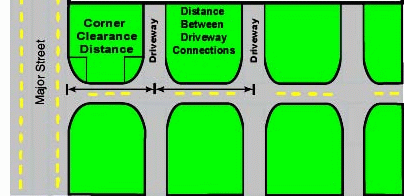940.14 Driveway Corner Clearance
Jump to navigation
Jump to search
Corner clearance represents the distance between the corner of the intersection of two public roadways and the next private driveway. It is important to provide enough distance between the corner and the first driveway to effectively separate conflict points and allow drivers enough time to make safe maneuvers. When corners are not adequately cleared, crash rates and delay increase. These guidelines correspond to the driveway spacing guidelines for the same roadway classification. However, maintaining adequate corner clearance is more critical for safety and operations than mid-block driveway spacing. This guideline only applies where the sight distance guideline allows.
| Roadway Classification | In Current and Projected Urban Areas | In Rural Areas |
|---|---|---|
| Major, Freeway | No driveways | No driveways |
| Major, Non-Freeway | 440 to 660 ft. | 660 to 1,320 ft. * |
| Minor | 220 to 330 ft. | 330 to 440 ft. * |
| * The urban guideline may be applied in developed areas that are not urban, for example, cities with populations under 5,000. On collectors in cities with population under 5,000, the guideline is 220 ft., the same as the urban guideline. | ||
